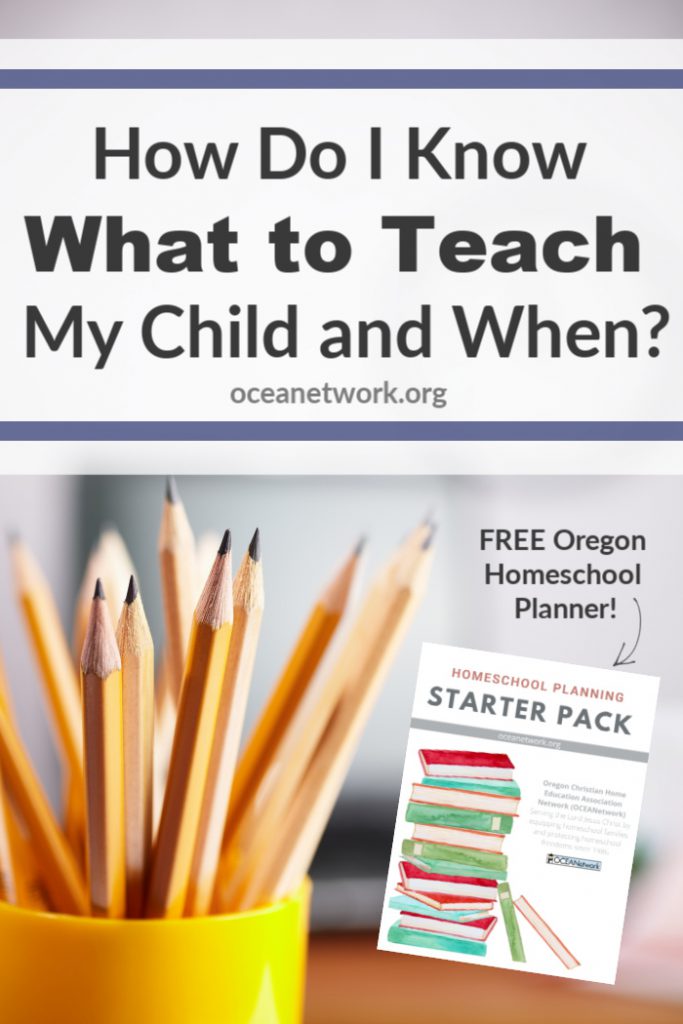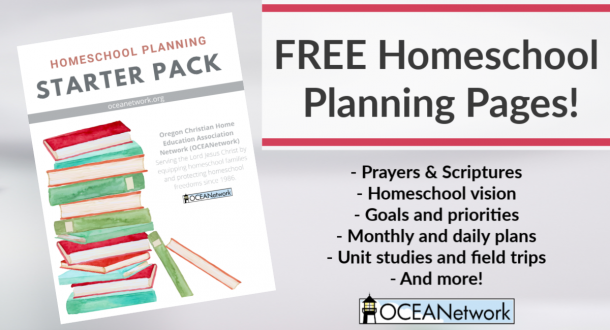In Oregon there are no legal requirements imposed upon parents about what to teach and when to teach it. This is a huge blessing and part of the homeschool freedoms that OCEANetwork works hard year-round to protect and expand!
However, parents are often left wondering what to teach children in their homeschool and when to teach it! This can seem overwhelming, especially if you try to replicate the public school requirements at home (which we do not recommend).
In this article, OCEANetwork co-founder Dorothy Karman shares some basic milestones that parents can use to plan out their homeschool course of study and look ahead into upcoming years.

What to Teach Your Child in Your Homeschool
Preschool to Kindergarten
Preschool through kindergarten years are for getting your child ready to learn. Reading aloud, engaging children in conversation, and developing number sense are all skills that can be reinforced as you go about your daily activities. The most important thing – talk to your children about everything.
First to Third Grade
The first three grades are the time to build the foundations in reading, writing, and arithmetic. Again, reading aloud, having conversations with your children, using math in everyday living are essential activities to go along with any book learning. A great resource for the first three grades is “The Three R’s,” by Dr. Ruth Beechick.
Fourth to Eighth Grade
Grades 4 through 8 are the time to consolidate and build on children’s skills in reading, writing, and arithmetic and to expose students to a wealth of knowledge. Studying content areas begins in earnest in these grades. In general, the skills of reading, writing, and arithmetic are taught sequentially, while content areas, such as science, history, and geography, can be taught in any order. Who says a child has to learn simple machines before he or she learns astronomy? These content areas provide a great opportunity for families to pursue interests of the moment – and learning is always deeper when pursuing interests. A good book to help you navigate Grades 4 – 8 is “You Can Teach Your Child Successfully,” by Dr. Ruth Beechick .
Essential Learning Objectives for K – 8th Grade
“Essential Learning Objectives” by Basic Skills Assessment Services is a list of math and language arts learning objectives and specific skills that are typically covered at each grade, kindergarten through eighth grade. Use it to help you determine which skills your child has mastered and which skills he needs to learn next. It is free when you sign up for the Ezine from Basic Skills .
High School
The courses studied by homeschool school students in high school determined in part by the student’s plans after high school. Courses are more rigorous and homeschool parents often feel inadequate to meet the challenges of high school. However, there are many options for learning for the high school student. The parent need not feel like he or she has to be an expert in every subject.
- Many of the textbooks for homeschool high school are designed so the student can self-instruct.
- Tutors on specific subjects may be available in your area.
- Parents can exchange teaching responsibilities – one parent may be strong in math and science and another in writing. They can team teach focusing on their strengths.
- Dual enrollment in high school and college is a possibility for some subjects.
- Many universities offer online courses for high school students.
Read more about high school requirements, diplomas, and tests.
Download the Homeschool Planning Starter Pack
We encourage homeschool families to prayerfully craft their home education around their own learning and family discipleship goals. To help you in that effort, we’ve provided a FREE set of homeschool planning pages to get you started!


This is so helpful. Thank you for providing this information.